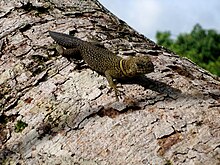Tropical Thornytail Iguana
| Tropical thornytail iguana | |
|---|---|
 |
|
| Scientific classification | |
| Kingdom: | Animalia |
| Phylum: | Chordata |
| Class: | Reptilia |
| Order: | Squamata |
| Family: | Iguanidae |
| Subfamily: | Tropidurinae |
| Genus: | Uracentron |
| Species: | U. flaviceps |
| Binomial name | |
|
Uracentron flaviceps (Guichenot, 1855) |
|
 |
|
| Approximate distribution of the Tropical Thornytail Iguana (in Brazil, its distribution extends as far east as the lower Madeira River) | |
| Synonyms | |
|
|
Uracentron flaviceps, the tropical thornytail iguana or Amazon thornytail iguana is an elusive species of medium-sized arboreal lizard found in the tropical lowlands of the Amazon Rainforest. The species was described by French zoologist Alphone Guichenot in 1855. They are considered to be ant specialists and exhibit communal nesting and a harem style breeding system in which there is one male to multiple females. Study of this species has been impeded by difficulties collecting and observing the species.
The species was originally named Doryphorus flaviceps by Guichenot in 1855. Since its original identification, the species has undergone a number of taxonomic changes. In 1881 it was renamed Uranocentrum flaviceps by O'Shaughnessy. This change did not last very long and the name was changed to Urocentron castor in 1885. There were only minor taxonomic changes after 1885 until a change to Uracentron flaviceps in 1925. This name lasted until 1992 when Darrel R. Frost renamed the species Tropidurus flaviceps. The name switched between Tropidurus flaviceps and Uracentron flaviceps until 2003, when the genus Tropidurus was split into several genera and the Tropical Thornytail Iguana was assigned to Uracentron.
The species has been noted in the lowlands of eastern Ecuador, eastern Peru, northwestern Brazil, and in the extreme southern regions of Colombia, they may be found in Bolivia as well.
Tropical thornytail iguanas are only found in the Amazon rainforest, and within the rainforest are generally found in lowland tropical rainforest; usually areas with lagoons, rivers, streams, and palm swamps. They are an arboreal species, spending the majority of their life in high tree tops. They prefer trees with high horizontal branches that allow for basking in the sun during the morning hours, and are almost only found in trees that contain hollow areas accessible through entrances in the tree branches and trunks. No specific species of tree has been found to be favored by the lizards, it would appear the tree structure, rather than the tree species, is what the lizards prefer.
...
Wikipedia
